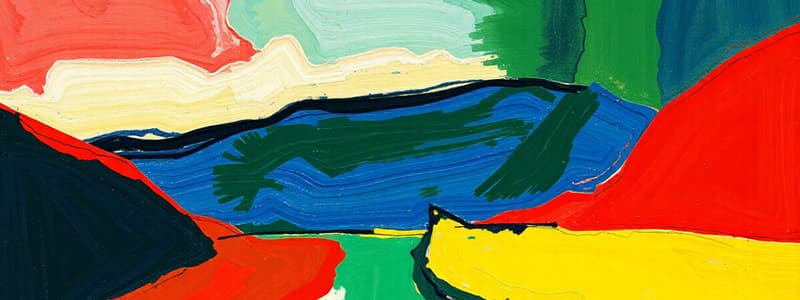Podcast
Questions and Answers
What is the primary purpose of using imagery in writing?
What is the primary purpose of using imagery in writing?
- To strictly follow grammatical rules
- To confuse the reader with complex words
- To maintain a formal tone
- To appeal to the senses of the reader (correct)
Which statement best describes a metaphor?
Which statement best describes a metaphor?
- A comparison that equates two things without using 'like' or 'as' (correct)
- A direct statement of fact
- A comparison using the words 'like' or 'as'
- A vivid description using sensory language
What does the metaphor 'the sea foam was salt and pepper' indicate?
What does the metaphor 'the sea foam was salt and pepper' indicate?
- The sea foam is dangerous to swimmers
- The sea foam adds visual variety to the waves (correct)
- The sea foam is colored blue and white
- The sea foam is heavy and difficult to see
Why might a writer choose to use a metaphor that does not make sense at first glance?
Why might a writer choose to use a metaphor that does not make sense at first glance?
How does the metaphor 'the lighthouse was a proud soldier' enhance the description?
How does the metaphor 'the lighthouse was a proud soldier' enhance the description?
What role does metaphor play in Lucy's description of her vacation?
What role does metaphor play in Lucy's description of her vacation?
What effect does the metaphor 'the wind was a cool knife' create?
What effect does the metaphor 'the wind was a cool knife' create?
What is one benefit of using strong imagery in creative writing?
What is one benefit of using strong imagery in creative writing?
What should a writer avoid when using metaphors?
What should a writer avoid when using metaphors?
What does the phrase 'the surface of the rocks was an oven' imply?
What does the phrase 'the surface of the rocks was an oven' imply?
Flashcards
Imagery
Imagery
Using vivid and descriptive language to appeal to the reader's senses, creating a strong impression of the subject.
Metaphor
Metaphor
A comparison between two unlike things without using 'like' or 'as'.
Descriptive Language
Descriptive Language
The act of using words to create a vivid sensory experience for the reader.
Writing Metaphors
Writing Metaphors
Signup and view all the flashcards
Unconventional Metaphor
Unconventional Metaphor
Signup and view all the flashcards
Metaphor to Reveal
Metaphor to Reveal
Signup and view all the flashcards
Simile
Simile
Signup and view all the flashcards
Vivid language
Vivid language
Signup and view all the flashcards
Strong Metaphor
Strong Metaphor
Signup and view all the flashcards
Appeal to the senses
Appeal to the senses
Signup and view all the flashcards
Study Notes
Imagery in Writing
- Imagery uses descriptive language to appeal to the reader's senses.
- It's crucial for engaging writing, making each word impactful.
- Imagery is used in creative writing, such as poetry.
Metaphors
- Metaphors are comparisons without 'like' or 'as.'
- They often use unexpected comparisons for strong impact.
- A metaphor can create new understanding of familiar things.
Example of Metaphors in Description
- "The waves were a soothing roar." The loud, continuous sound of the waves is compared to a soothing noise.
- "The sea foam was salt and pepper sprinkled on top of the waves." The foam is visualized as a mixture of salt and pepper atop the waves.
- "The people on the opposite shore were brightly colored beetles, crawling back and forth." The appearance of people from a distance is likened to small, colored insects moving.
- "The surface of the rocks was an oven, but the wind was a cool knife." The rocks are viewed as hot and the wind as a cool, sharp object to contrast the temperatures.
- "The lighthouse was a proud soldier, guarding the whole scene." The lighthouse is visualized as a tall, strong figure safeguarding the surrounding area.
Writing Metaphors
- Begin by identifying the subject to describe.
- Use your five senses and emotions to understand the described object.
- Use action-oriented phrases when creating the comparisons.
- Use metaphors to express thoughts and feelings about the described item.
Studying That Suits You
Use AI to generate personalized quizzes and flashcards to suit your learning preferences.
Description
This quiz explores the essential elements of imagery and metaphors in writing. Delve into how descriptive language enriches creative works, enhancing the reader's sensory experience. Test your understanding of these literary devices through illustrative examples.




